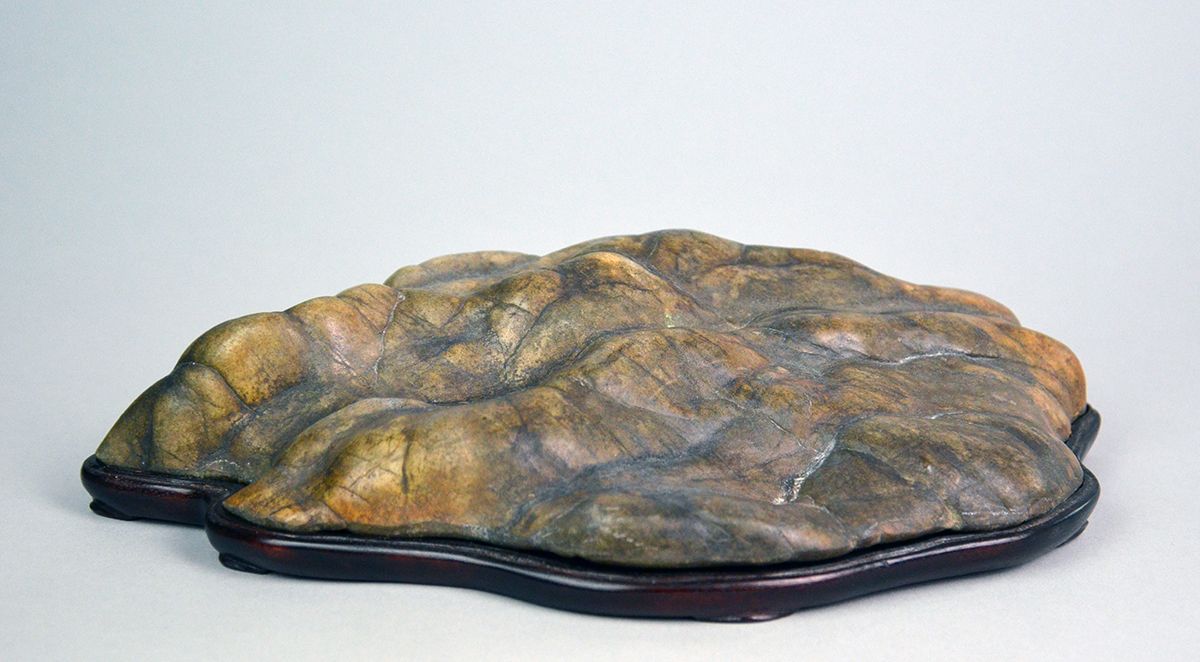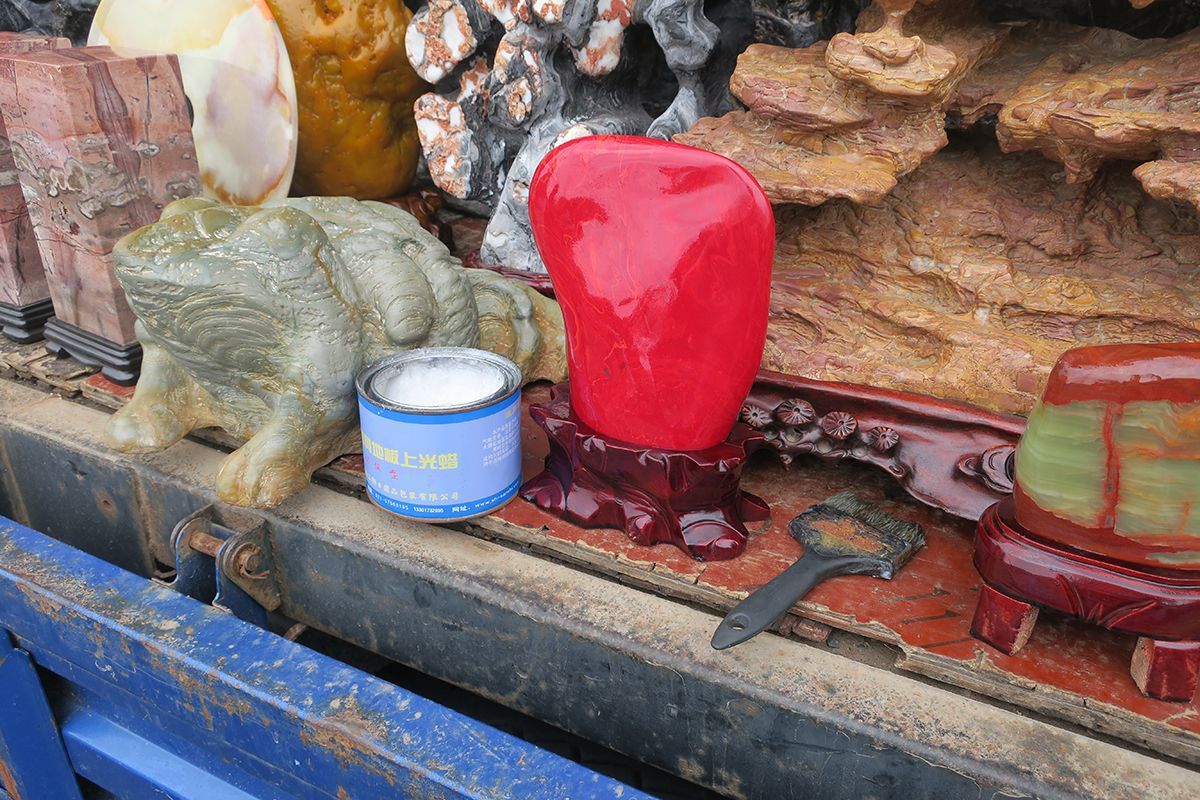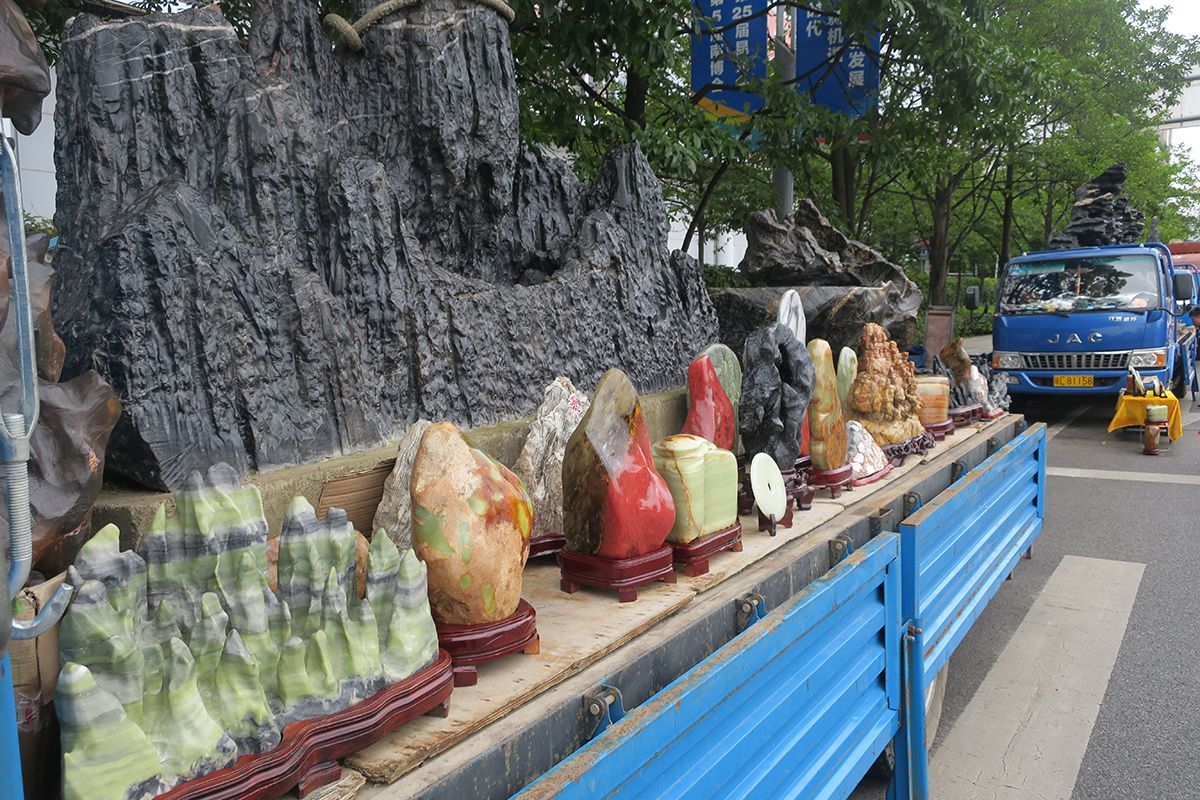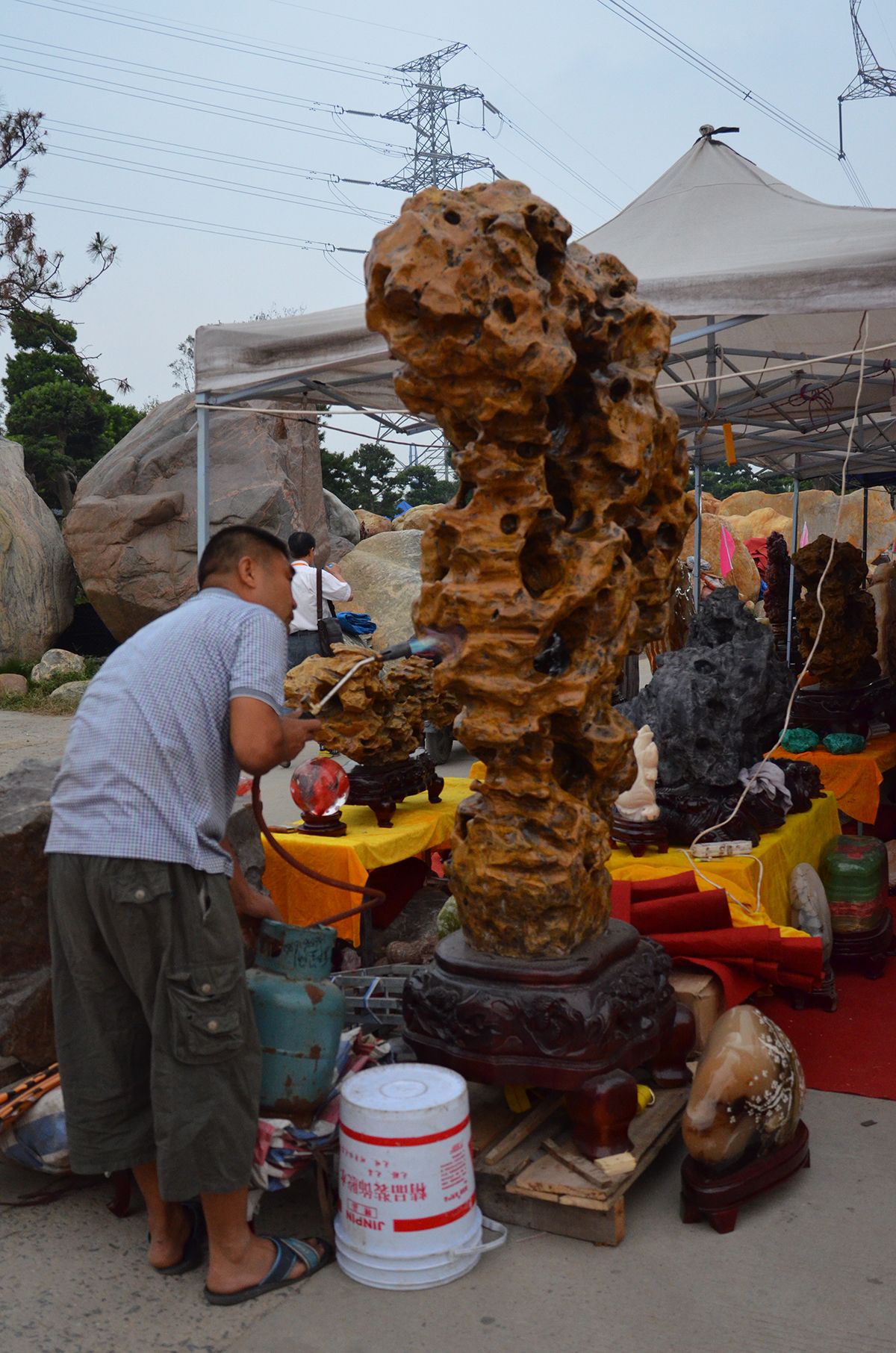The Unspoken Role of Oils and Waxes in Viewing Stone Appreciation
A detailed account of the global use of oils and waxes on viewing stones
By Thomas S. Elias
Most viewing stone collectors consider natural unaltered rocks to be of higher quality than ones that have been enhanced chemically or mechanically in some way. Despite that belief, the use of different natural oils, waxes, and mineral oil on stones is common globally. Indeed, collectors and dealers often (and perhaps unknowingly) deposit their skin oils and water on the surface of their stones when cleaning them to remove dirt and rinds and periodically rubbing the stone’s surface. However, the application of these products to improve the appearance of a viewing stone is rarely discussed or written about in the many books, exhibition catalogs, and articles relating to the appreciation of selected stones for their aesthetic qualities. Records of oil and wax applications and other enhancements are typically not included in the provenance records accompanying a viewing stone that is passed from one collector to another over time.
Over the last forty-five years, I have travelled extensively throughout Asia, especially China and Japan, studying stone appreciation, plants and gardens, and the practice of bonsai and penjing. My travels also included many trips to Europe to visit stone collectors and attend exhibitions. This gave me the opportunity to observe how viewing stones were collected, cleaned and processed for sale, prepared for exhibitions, and how they were treated in individual collections. More recently, I have surveyed several experienced stone collectors and dealers about the practice of using oils and waxes on stones. In this article, I will share with you my observations, experiences, and information gained about this subject.

Oils and waxes will darken the surface color of many types of rocks, particularly the more porous limestone and other carbonate rocks. As stone collectors, we are told that darker colored rocks are more desirable because they impart a feeling of oldness, and are quieter and more subtle than lighter rocks. Lighter colored rocks can give the impression of being younger, fresh, and more vibrant. The application of oils and waxes will also cause surface features to stand out. Different mineral inclusions, fine mineral veins and different types of grains become more apparent with the use of oils and certain waxes. While these changes can make a stone’s features more evident and more visually appealing to some, it is contrary to the Asian aesthetic qualities of subtle or quiet beauty found in nature. Serious stone collectors and connoisseurs of Asian stone appreciation find the excessive use of oils and waxes to be contrary to their aesthetics. Matsuura (2010) wrote that “In some countries, it has become standard practice to oil stones, polish them, or apply wax or lacquer coating to give them a glossy sheen, though this is highly looked down upon in Japan as it creates an unnatural appearance.” However, Matsuura didn’t address the minimal use of certain oils and waxes combined with other methods of cultivating a stone that improves an aged appearance and darkens a stone without a glossy sheen. The focus of this paper is to address the silence about oiling and waxing processes to enhance stone aesthetics and sales.


These heavily waxed colorful stones offered for sale at the 2018 Kunming Pan Asian Exposition are suitable as tourist souvenirs rather than as genuine Chinese Scholar stones.
The most frequently encountered obvious use of oils and waxes on stones are in some stone shops or dealers sales areas prior to known customer visits, or in preparation for photographing a stone for a book or placement on an online sales site. In some countries, selected stones are lightly oiled immediately before a stone is displayed in a major exhibition.
I have visited viewing stone shops in many countries and noticed a distinct difference between those managed by businessmen versus those curated by knowledgeable and serious stone connoisseurs. In some Chinese shops operated by sales-oriented managers, many of the medium to larger size rocks had an obvious sheen and wet appearance. When I touched these rocks, I felt a thick layer of oil. Off to one side, I noticed a large can half filled with mineral oil with a paint brush half immersed in the oil. My time in this shop was short, and after this experience, I always carried an extra handkerchief with me. The same experience has been repeated several times on trips to Asia. The excessive use of oils on stones by some dealers may be due to a lack of understanding the aesthetics of traditional stone appreciation.
First, natural oils and waxes are ubiquitous in nature. Waxes are found on the surfaces of most plants leaves, and oils are found in the seeds of many different plant species (Linseed, Tung, and Teak) and human skin. Also, many insects secrete wax such as beeswax. Natural plant oils are primarily glycerol and fatty acids with minor components that affects its color, odor, and antioxidant activity (resistance to oxidation by air). Waxes are made of more complex fatty acids and alcohols which account for some wax being solid or semi-solid at room temperatures. Waxes do not penetrate into stone micropores as readily as oils do, unless they are heated until they become liquid. Waxes will form a protective barrier on the surface of a stone, while oils penetrate into many types of stones with the exception of hard silicacous rocks.
Mineral oil is an inexpensive, petroleum-based product that is clear, odorless, safe, and used in wide applications. It is the most widely used oil on viewing stones in the world. In addition to selected, non-aromatic natural oils, a combination of oil and wax products are also readily available and used on stones.
While attending a large outdoor gathering of stone vendors at a major stone convention in China several years ago, I notice a fellow working on a large Taihu stone. Most of these stones are typically whitish to cream-colored in their natural condition, but this one was a darker brownish orange in color. He was applying a soft paste wax to the surface of the Taihu stone using a cloth. Then he used a blow torch to heat the wax. When asked why he was doing this, he responded that he is trying to darken the color of the stone. Darker stones sell better! The heat from the blow torch causes the stone to expand slightly and the wax to melt as it filled the pores in the stone. Carbonization of the wax by the torch causes the wax to darken. I have observed this process on several occasions in China.

Mineral oil and wax for sale at a Chinese stone market.
When I first began to learn about Japanese suiseki, I was informed that the rocks used in suiseki practice were always natural. However, the more time I spent travelling throughout Japan talking with dealers and recognized suiseki authorities, I learned that Japanese suiseki are sometimes treated with oils or waxes to help create a suitable patina. These treatments are documented in a Japanese book by Murata (1966) and in another book by Inoue (1966). These were published in the early part of the peak of popularity of Suiseki in Japan. They chronicle the use of waxes and oils on stones at this time. The use of Kentoku wax, a liquid wax used on wood products and furniture, was the most commonly used agent. These books also record the use of Ibota wax on suiseki, especially Furuya stones. This is a wax that is produced by the female Ibota scale insect on the plants they feed upon. This soft, easily pliable wax, is used as a lubricant for traditional Japanese sliding doors, polishing Paulownia wood, and in candles and certain textiles. Murata and Inoue also cite the use of Shirashime oil on suiseki. Shirshime oil is a refined whitish oil made from canola or soy bean seeds, and is used in Japan for deep frying foods, particularly tempura. There is even a mention of the use of hand creams on suiseki in these volumes.
I spent many days with one of Japan’s leading stone carvers, Sakurai Toshio, in his factory and his home. He used the Kentoku liquid wax on many of his carved stones. This wax is a proprietary blend of natural oils and waxes selected for their protective and subtle aesthetic appearance. Camellia is one of the oils used in Kentoku due to its abilities to enhance features of a stone and it leaves a subtle sheen more in keeping with Japanese Suiseki aesthetics. Although this wax was originally designed for use on wood and metal surfaces, he applied this to stones, wiped them, and then placed them outdoors exposed to the elements for a few months to let the oxygen in air oxidize—hence darken—the wax, before he sold it to dealers in Japan. This process eliminated any obvious signs of a stone being recently oiled. He told me that he would never sell a recently oiled stone.
Can of Kentoku furniture wax. The practice of Yoseki or cultivating stones outdoors of doors for several months.
The late Kasahara Manabu, owner of Sansui-en and one of the first full-time stone dealers in Tokyo, was one of my mentors in Japan. We spent many hours discussing Japanese suiseki in his shop in Tokyo. At a follow up meeting to a prior discussion about patina, he handed me a small box containing a very soft easily pliable substance. Kasahara said it is used by some suiseki collectors and dealers to improve the surface appearance of stones that have been cleaned. The soft almost powdery natural wax is placed in a small soft cloth bag and massaged so that wax thoroughly penetrates the cloth. The hand-held bag is then rubbed against the rock’s surfaces to deposit a thin layer of Ibota wax on the stone. This is one way to create a beautiful yet subtle patina to Japanese suiseki. This treatment is used on certain Furuya, Seigaku, and other stones with smooth surfaces.
Information obtained from Sakurai and Kasahara confirm the continued use of oils and waxes on Japanese suiseki from the mid-1960s to the present. Since Kentoku, Ibota wax, and Shirasmime-yu oil have long been associated with Japanese arts, crafts, and cooking, I suspect the use of these agents on stones has a longer history.
Natural Ibota wax flakes and Camellia oil is occasionally used on viewing stones by some collectors.
On another occasion, I was judging a viewing stone exhibit in the Philippines. As I moved along the display table, I noticed an attractive, medium-size black abstract-shaped stone with a questionable patina. On closer examination, the surface color appeared fresh and not with a softer aged patina. I stuck my finger in a small cavity in the stone and the end of my finger was dripping with oil. The owner of the stone admitted applying mineral oil to the stone just before the exhibition, but he had tried to carefully wiped the stone with a cloth to remove any excess oil, except for the small pockets and depressions in the stone.
Mineral oil is sometimes used in Korea on select stones before an exhibition and in shops offering stones for sale. I was surprised to see this because I read and saw their strong preference for natural, unaltered stones. Korean Suseok enthusiasts like to spray water on stone and watch the pattern as the stone dry; however, this is a short-lived phenomenon. Some believe that applying oil has the advantage of enjoying the colors and enhanced features for a longer period. This is counter to the aesthetic of fleeting beauty found in nature. Apparently, applying oil is not considered to be altering a stone in this country.
Oils and waxes are also used on stones in Europe and North America. In Europe, a lighted beeswax candle is placed in front of a hot air drier so that as the beeswax melts and drops on the stone, it spreads on the surface of a stone. I learned in my survey that even hand and moisturizing creams are used in southern Europe. The creams are applied to the stones followed by repeatedly rubbing the stone with a cloth. Stones treated with beeswax and creams are repeatedly hand rubbed with pantyhose and/or a woolen cloth. Rubbing a stone in this manner over time will result in a natural appearing surface.
In North America, I have seen Camellia and mineral oil used to treat stones, and I have been informed that Coconut oil is also used. The more expensive Camellia oil is preferred because it leaves a more understated patina-like appearance. In a personal demonstration several years ago, I was shown how to apply a Swedish organic oil-wax combination composed of Bayberry wax, beeswax, and Linseed oil to a large Chinese stone. The stone was darkened slightly by this combination by rubbing this material on the stone’s surface using a soft cloth. The color change has remained in this condition for the last ten years. These natural refined oils are safe to use.
If you purchased a stone, especially a stone from China or Japan, there is a good probability that it has been treated with an oil or wax at sometime during its history as a collected object. It is nearly impossible to tell if a stone’s color has been darkened by the use of these materials or if the patina has been altered many years ago. The original oil may have been oxidized or volatilized over time, but the initial changes to a stone’s surface can be permanent.
What drives people to want to improve on nature (naturally occurring rocks) rather than accepting these more subtle, less conspicuous features, natural patina, and imperfections on rocks? Is it monetary since many people find a treated stone to be more “attractive” and appealing to their aesthetic sensibilities than completely nature stones? Or is it due to a competitive spirit where an individual collected wants to have and display a stone that has perceived superior qualities to other stones in a collection or exhibition?
I have experimented with a few stones using natural oils and tannins as I was learning about the treatments of altered stones. One such experiment was to use fresh coffee grounds and a small piece of limestone. The stone was immersed in a container filled with unbrewed coffee grounds, and left it for several months. When the stone was removed, it was nearly black due to the rich mixture of naturally occurring oils in coffee beans. It now has a subtle, non-shiny patina that is usually associated with an aged stone. Three years later, the stone has not changed color, and the surface remains dull black that gives the impression of a rock that has been in a collection for many years.
Before and after treatment with fresh coffee grounds. The stone is 14.5 x 7 x 7.5 cm
I prefer to not use oils or waxes on our personal collection of viewing stones. I am well aware that a number of our stones were oiled or waxed before we acquired them; however, we do not continue that treatment. Over several decades, I slowly developed a greater appreciation for natural stones and their imperfect features rather than the near perfect forms, colors, and patina of enhanced stones. Stone dealers and certain collectors will continue to use oils and waxes on stones, for monetary or aesthetic reasons, and continue to omit this information in the provenance records associated with a stone. It is important for new stone collectors to be aware of the widespread practice. The only stones you can be assured of as not having been altered with oils and waxes are the ones you collected yourself.
References:
Inoue, Y. 1966. Suiseki no Mitate to Teire (How to Appreciate and Care for Suiseki), Tokuma Shoten, Tokyo.
Matsuura, A. 2010. An Introduction to Suiseki. Translated and adopted by Wil Lautenschlager. Privately published by Matsuura Arishige in cooperation with the Nippon Suiseki Association. Tokyo. 87 pages.
Murata, Keiji, Ed. 1966. Suiseki no Yashiyai-kata, Migaki-kata (Creation: How to Cultivate and Polish Suiseki. Juseki-sha), Tokyo. 152 pages.

